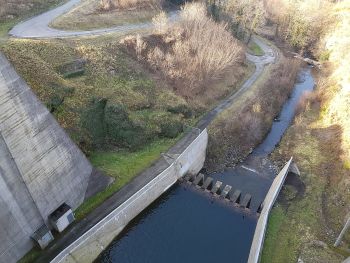Spillway Terminal Structure Hydraulics

|
| Spillway with energy dissipation system.
(Image Source: Luppanox, Creative Commons) |
“The design of the energy dissipator probably includes more options than any other phase of spillway design. The selection of the type and design details of the dissipator is largely dependent upon the pertinent characteristics of the site, the magnitude of energy to be dissipated, and to a lesser extent upon the duration and frequency of spillway use. Good judgement is imperative to assure that all requirements of the particular project are met. Regardless of the type of dissipator selected, any spillway energy dissipator must operate safety at high discharges for extended periods of time without having to be shut down for emergency repairs. An emergency shutdown of the spillway facility during a large flood could cause overtopping of the dam and/or create unacceptable upstream flooding.” [1]
“Except in some unusual conditions, an exit channel is required to transition between the stilling basin and the main channel of the river. Since dissipation of the entire spillway discharge energy within the stilling basin is not normally accomplished, enlarging the channel width immediately downstream from the (stilling) basin will assist in dissipating the residual energy. Due to the erosive nature of the highly turbulent flow exiting from a stilling basin, protection of the exit channel bed and side slopes is usually required to prevent channel scour and potential undermining of the stilling basin.” [1]
Learn more about this topic here: Energy Dissipation
Best Practices Resources
![]() Hydraulic Design of Spillways (EM 1110-2-1603), USACE
Hydraulic Design of Spillways (EM 1110-2-1603), USACE
Citations:
Revision ID: 7464
Revision Date: 07/27/2023
